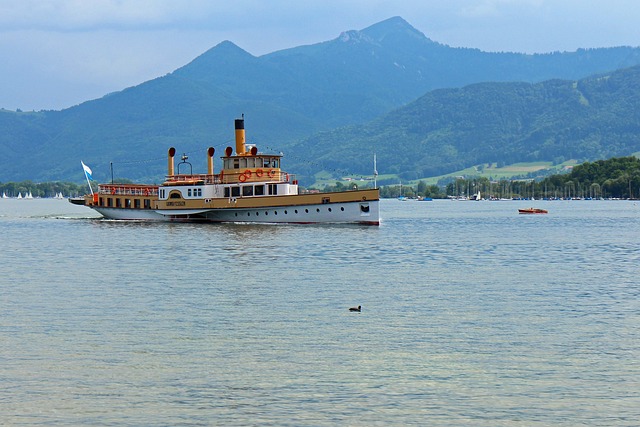
Category: Kayaking in the Siuslaw River
Kayaking in the Siuslaw River: A Comprehensive Exploration
Introduction
In the heart of Oregon’s coastal region lies a captivating waterway that has become a haven for water enthusiasts—the Siuslaw River. This winding river, with its pristine waters and diverse ecosystems, offers an unparalleled experience for kayakers seeking adventure and exploration. Kayaking in the Siuslaw River is more than just a recreational activity; it represents a unique blend of natural beauty, cultural heritage, and outdoor recreation that has garnered national attention. This article aims to take readers on a comprehensive journey through the world of kayaking in this remarkable river, delving into its history, significance, global impact, and future prospects. By exploring various facets, we will uncover why this activity is not just a pastime but a dynamic element within the broader landscape of outdoor sports and regional economies.
Understanding Kayaking in the Siuslaw River: A Definition and Historical Context
What is Kayaking?
Kayaking refers to the sport or recreational activity of paddling a kayak, a small watercraft designed for maneuverability and stability. It involves propelling oneself forward using a double-bladed paddle, allowing kayakers to navigate rivers, lakes, and coastal waters. Kayaking has evolved from its ancient roots in indigenous cultures worldwide to become a popular outdoor activity enjoyed by people of all ages and skill levels.
Kayaking in the Siuslaw River: A Unique Experience
The Siuslaw River, stretching approximately 110 miles along Oregon’s coast, offers a diverse range of kayaking experiences. From gentle, slow-moving stretches suitable for beginners to rapid, challenging sections that appeal to experienced paddlers, this river caters to all levels. The historical significance of the Siuslaw River extends back thousands of years, with indigenous tribes such as the Siuslaw and Coos people relying on it for sustenance, transportation, and cultural practices. Today, kayaking in this river provides a direct connection to this rich heritage while offering modern adventurers breathtaking scenery and wildlife encounters.
Core Components:
- Kayak Types: Kayaks designed for rivers vary in size, shape, and material, each suited to different water conditions and paddling styles. In the Siuslaw River, both recreational kayaks for leisurely floats and whitewater kayaks for more adventurous excursions are popular.
- Paddling Techniques: Paddlers use a variety of strokes to maneuver their kayaks. Forward strokes, sweep strokes, and J-strokes are commonly employed in different river sections to navigate turns, avoid obstacles, and maintain control.
- River Navigation: Understanding river flows, currents, and potential hazards is crucial for safe kayaking. The Siuslaw River’s diverse character requires kayakers to adapt their techniques accordingly.
Global Impact and Trends
Kayaking in the Siuslaw River does not operate in isolation; it is part of a global phenomenon that has seen significant growth and evolution over the past few decades.
International Influence:
- Outdoor Recreation Boom: The world has witnessed a surge in outdoor recreation, with activities like kayaking gaining immense popularity. This trend is driven by a growing desire for connection to nature, adventure, and health benefits.
- Cultural Exchange: Kayaking has become an international language, bringing people from diverse backgrounds together on waterways worldwide. It fosters cultural exchange and understanding as kayakers share techniques, stories, and respect for the environment.
Key Trends Shaping Kayaking:
- Eco-Tourism: The Siuslaw River’s natural beauty and ecological significance have positioned it as a prime destination for eco-tourists seeking sustainable outdoor experiences. Kayaking offers a unique perspective for observing wildlife and appreciating the river’s ecosystem.
- Community Engagement: Local kayaking communities are forming worldwide, fostering a sense of camaraderie and shared passion. These communities often advocate for river conservation, promoting responsible kayaking practices.
- Technological Integration: GPS devices, satellite communication, and advanced water monitoring systems are enhancing the kayaking experience. They provide real-time data on river conditions, improving safety and navigation.
Regional Impacts:
- North America: The United States and Canada have seen a significant rise in kayaking popularity, with rivers like the Siuslaw River attracting both local and international paddlers.
- Europe: Rivers in Europe, such as those in Germany and Switzerland, are popular kayaking destinations, known for their scenic beauty and challenging rapids.
- Asia: Countries like Japan and China have emerging kayaking communities, often combining traditional canoe styles with modern kayak designs.
Economic Considerations
The economic implications of kayaking in the Siuslaw River are multifaceted, impacting local businesses, tourism, and regional development.
Market Dynamics:
- Local Tourism: Kayaking tours and rentals contribute significantly to the local economy, attracting visitors who spend money on accommodations, dining, and other recreational activities.
- Equipment Sales: The demand for kayaking gear, including kayaks, paddles, and safety equipment, generates revenue for specialty stores and online retailers.
- Guided Tours vs. Self-Guided Paddles: Tour companies offer guided kayaking experiences, providing expert knowledge and enhancing safety. This model has proven successful in regions like the Siuslaw River area.
Investment Patterns:
- Infrastructure Development: Investments in river access points, launch facilities, and rest areas improve the overall kayaking experience and attract more visitors.
- Community Initiatives: Local communities often invest in kayak parks, trails, and conservation efforts to enhance their appeal as kayaking destinations.
Economic Impact on Regional Systems:
- Job Creation: Kayaking tourism supports various jobs, from tour guides and rental shop staff to accommodation providers and restaurant workers.
- Tax Revenue: The economic activity generated by kayakers contributes to local and regional tax revenues, funding public services and infrastructure development.
- Environmental Conservation: Economic incentives for responsible kayaking practices can encourage conservation efforts, preserving the river’s ecological integrity.
Technological Advancements
Technology plays a pivotal role in enhancing the kayaking experience, improving safety, and shaping future trends.
Current Technologies:
- GPS and Navigation Systems: Kayakers utilize GPS devices to track their routes, monitor speed, and receive real-time river condition updates. These tools are essential for navigating complex sections of the Siuslaw River.
- Communication Devices: Satellite communication systems enable kayakers to make emergency calls and stay connected while exploring remote areas of the river.
- Water Quality Monitoring: Advanced sensors and monitoring systems provide data on water quality, helping kayakers avoid potential hazards and contributing to scientific research.
Future Potential:
- Drones for Surveillance: Drones equipped with high-resolution cameras can survey river conditions, map locations, and assist in search and rescue operations.
- Artificial Intelligence (AI): AI algorithms could analyze historical data to predict river flows, identify potential hazards, and offer personalized paddling routes.
- Smart Kayaks: The development of kayaks with integrated sensors and communication systems will provide real-time data on kayak performance and environmental conditions.
Policy and Regulation
Governing kayaking activities in the Siuslaw River is crucial for ensuring safety, protecting the environment, and fostering responsible use.
Key Policies and Regulations:
- National Park Service Guidelines: The Siuslaw River falls within the boundaries of a national park or protected area, subject to specific regulations regarding water access, camping, and waste management.
- State Water Quality Standards: Oregon’s environmental protection agency sets standards for water quality, including limits on pollutants and guidelines for safe recreation. Kayakers must adhere to these regulations to protect the river’s ecosystem.
- Wildlife Protection Laws: Interacting with wildlife, such as seals, otters, and birds, is regulated to prevent disturbing their habitats and ensuring the safety of both animals and kayakers.
Legislative Frameworks:
- River Management Plans: Comprehensive plans are developed to manage river resources sustainably, including provisions for kayaking activities while considering ecological, cultural, and economic factors.
- Permitting Systems: Some sections of the Siuslaw River may require permits for kayaking, especially in protected areas or during peak seasons, to control access and minimize environmental impact.
- Safety Regulations: Local authorities enforce safety standards, including mandatory life jackets, specific river conditions guidelines, and training requirements for commercial tour operators.
Challenges and Criticisms
Despite its growing popularity, kayaking in the Siuslaw River faces several challenges that require thoughtful strategies to address.
Main Challenges:
- Environmental Concerns: Increasing water traffic can impact the river’s ecology, especially in sensitive habitats. Managing kayak access and promoting responsible practices are essential.
- Safety Issues: The Siuslaw River presents various risks, from strong currents to wildlife encounters. Ensuring kayakers’ safety through education, training, and regulatory measures is a constant concern.
- Resource Allocation: Balancing the economic benefits of kayaking with potential environmental and cultural impacts requires careful planning and funding for conservation efforts.
Criticisms and Solutions:
- Overcrowding: Popular sections of the river may become overcrowded, impacting the experience and causing environmental damage. Implementing booking systems or seasonal limitations could help manage traffic.
- Wildlife Disturbance: Kayakers sometimes inadvertently disturb wildlife. Educational campaigns promoting responsible wildlife viewing practices can mitigate this issue.
- Lack of Access: Some communities along the river lack adequate access points. Investing in infrastructure to provide safe launch and take-out facilities is crucial.
Case Studies: Successful Applications and Lessons Learned
Case Study 1: The Oregon Coast Kayaking Festival
This annual event celebrates kayaking on the Oregon coast, including the Siuslaw River. It attracts expert kayakers from around the world to compete in various disciplines while showcasing local culture and natural beauty. The festival has contributed to economic growth through tourism, fostered a sense of community among kayakers, and raised awareness for river conservation efforts.
Lessons Learned:
- Community Engagement: Involving local communities in organizing and promoting events builds support and ensures the event aligns with regional priorities.
- Sustainable Tourism: Balancing tourism promotion with environmental stewardship is essential for long-term success and community acceptance.
- Cultural Preservation: Incorporating indigenous cultural elements into festivals respects local heritage and enhances cultural exchange among participants.
Case Study 2: Siuslaw River Conservation Initiative
A collaboration between environmental groups, local businesses, and government agencies, this initiative aims to protect the river’s ecosystem while promoting sustainable kayaking practices. It involves creating protected areas, implementing pollution control measures, and educating kayakers about responsible river use.
Key Outcomes:
- Habitat Preservation: Protected areas along the river have led to a resurgence in wildlife populations, benefiting both nature and kayaking experiences.
- Public Awareness: Educational campaigns have empowered kayakers to make environmentally conscious choices, reducing pollution and negative impacts.
- Community Collaboration: The initiative has fostered partnerships between conservation groups, businesses, and government bodies, leading to more effective river management.
Future Prospects: Emerging Trends and Strategic Considerations
The future of kayaking in the Siuslaw River holds immense potential for growth, innovation, and positive environmental impact.
Potential Growth Areas:
- Eco-Tourism Expansion: With growing interest in sustainable travel, eco-tourism along the Siuslaw River is poised to expand, attracting environmentally conscious travelers.
- Technologically Enhanced Experiences: The integration of virtual reality (VR) and augmented reality (AR) could offer immersive kayaking experiences, allowing people worldwide to explore the river virtually.
- Community-Based Kayaking Programs: Local initiatives focusing on kayaking as an educational tool for schools and community development can engage younger generations and promote environmental stewardship.
Emerging Trends:
- Kayak Tourism Packages: Tour operators are likely to offer comprehensive kayak tourism packages, combining paddling adventures with cultural experiences, accommodations, and dining.
- Personalized Kayaking Experiences: Customized tours tailored to individual preferences and skill levels will cater to a diverse range of kayakers.
- River Conservation Partnerships: Collaboration between local communities, businesses, and environmental organizations will intensify, driving sustainable river management practices.
Strategic Considerations:
- Sustainable Development: Prioritizing environmental sustainability should be at the core of any growth strategy, ensuring the river’s ecological health for future generations of kayakers.
- Community Involvement: Engaging local communities in decision-making processes and empowering them to lead conservation efforts fosters a sense of ownership and ensures long-term success.
- Educational Programs: Developing educational initiatives focused on kayaking safety, river ecology, and cultural heritage will enhance the overall experience while promoting environmental awareness.
Conclusion: Paddling Towards a Brighter Future
Kayaking in the Siuslaw River is more than just a recreational activity; it represents a dynamic intersection of outdoor recreation, cultural heritage, and environmental stewardship. Through understanding its history, global context, economic impact, technological advancements, and future prospects, we can appreciate its significance and potential. By addressing challenges, learning from successful initiatives, and embracing emerging trends, the Siuslaw River’s kayaking community can navigate a path towards sustainable growth and worldwide recognition. This article has provided a comprehensive exploration of this remarkable activity, highlighting why kayaking in the Siuslaw River continues to captivate and inspire adventurers from all walks of life.
FAQ Section: Addressing Common Concerns
Q: Is kayaking in the Siuslaw River safe for beginners?
A: The Siuslaw River offers sections suitable for beginners, typically those with calm waters and gentle currents. It’s essential to follow local guidelines, wear appropriate safety gear, and consider taking a guided tour until you gain confidence.
Q: What equipment do I need for kayaking in the river?
A: You’ll require a kayak, a paddle, a personal flotation device (PFD), and appropriate clothing. Consider renting or purchasing gear based on your skill level and the river section you plan to explore.
Q: Are there any restrictions on kayaking in protected areas?
A: Yes, national parks and protected areas often have specific regulations regarding water access and activities. It’s crucial to obtain permits if required and adhere to guidelines to preserve these sensitive ecosystems.
Q: How can I contribute to river conservation efforts?
A: Participate in local clean-up events, support conservation organizations, and practice responsible kayaking by minimizing your environmental impact. Educating yourself about the river’s ecology and cultural significance is also valuable.
Q: Can kayaking in the Siuslaw River be a career?
A: While kayaking guides and tour operators may find it fulfilling as a career, it’s not typically a primary source of income. Many professionals combine their love for kayaking with other jobs while contributing to river conservation efforts.









